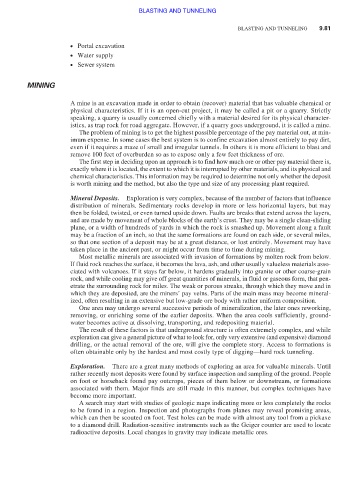Page 481 - Moving the Earth_ The Workbook of Excavation
P. 481
BLASTING AND TUNNELING
BLASTING AND TUNNELING 9.81
Portal excavation
Water supply
Sewer system
MINING
A mine is an excavation made in order to obtain (recover) material that has valuable chemical or
physical characteristics. If it is an open-cut project, it may be called a pit or a quarry. Strictly
speaking, a quarry is usually concerned chiefly with a material desired for its physical character-
istics, as trap rock for road aggregate. However, if a quarry goes underground, it is called a mine.
The problem of mining is to get the highest possible percentage of the pay material out, at min-
imum expense. In some cases the best system is to confine excavation almost entirely to pay dirt,
even if it requires a maze of small and irregular tunnels. In others it is more efficient to blast and
remove 100 feet of overburden so as to expose only a few feet thickness of ore.
The first step in deciding upon an approach is to find how much ore or other pay material there is,
exactly where it is located, the extent to which it is interrupted by other materials, and its physical and
chemical characteristics. This information may be required to determine not only whether the deposit
is worth mining and the method, but also the type and size of any processing plant required.
Mineral Deposits. Exploration is very complex, because of the number of factors that influence
distribution of minerals. Sedimentary rocks develop in more or less horizontal layers, but may
then be folded, twisted, or even turned upside down. Faults are breaks that extend across the layers,
and are made by movement of whole blocks of the earth’s crust. They may be a single clean-sliding
plane, or a width of hundreds of yards in which the rock is smashed up. Movement along a fault
may be a fraction of an inch, so that the same formations are found on each side, or several miles,
so that one section of a deposit may be at a great distance, or lost entirely. Movement may have
taken place in the ancient past, or might occur from time to time during mining.
Most metallic minerals are associated with invasion of formations by molten rock from below.
If fluid rock reaches the surface, it becomes the lava, ash, and other usually valueless materials asso-
ciated with volcanoes. If it stays far below, it hardens gradually into granite or other coarse-grain
rock, and while cooling may give off great quantities of minerals, in fluid or gaseous form, that pen-
etrate the surrounding rock for miles. The weak or porous streaks, through which they move and in
which they are deposited, are the miners’ pay veins. Parts of the main mass may become mineral-
ized, often resulting in an extensive but low-grade ore body with rather uniform composition.
One area may undergo several successive periods of mineralization, the later ones reworking,
removing, or enriching some of the earlier deposits. When the area cools sufficiently, ground-
water becomes active at dissolving, transporting, and redepositing material.
The result of these factors is that underground structure is often extremely complex, and while
exploration can give a general picture of what to look for, only very extensive (and expensive) diamond
drilling, or the actual removal of the ore, will give the complete story. Access to formations is
often obtainable only by the hardest and most costly type of digging—hard rock tunneling.
Exploration. There are a great many methods of exploring an area for valuable minerals. Until
rather recently most deposits were found by surface inspection and sampling of the ground. People
on foot or horseback found pay outcrops, pieces of them below or downstream, or formations
associated with them. Major finds are still made in this manner, but complex techniques have
become more important.
A search may start with studies of geologic maps indicating more or less completely the rocks
to be found in a region. Inspection and photographs from planes may reveal promising areas,
which can then be scouted on foot. Test holes can be made with almost any tool from a pickaxe
to a diamond drill. Radiation-sensitive instruments such as the Geiger counter are used to locate
radioactive deposits. Local changes in gravity may indicate metallic ores.

